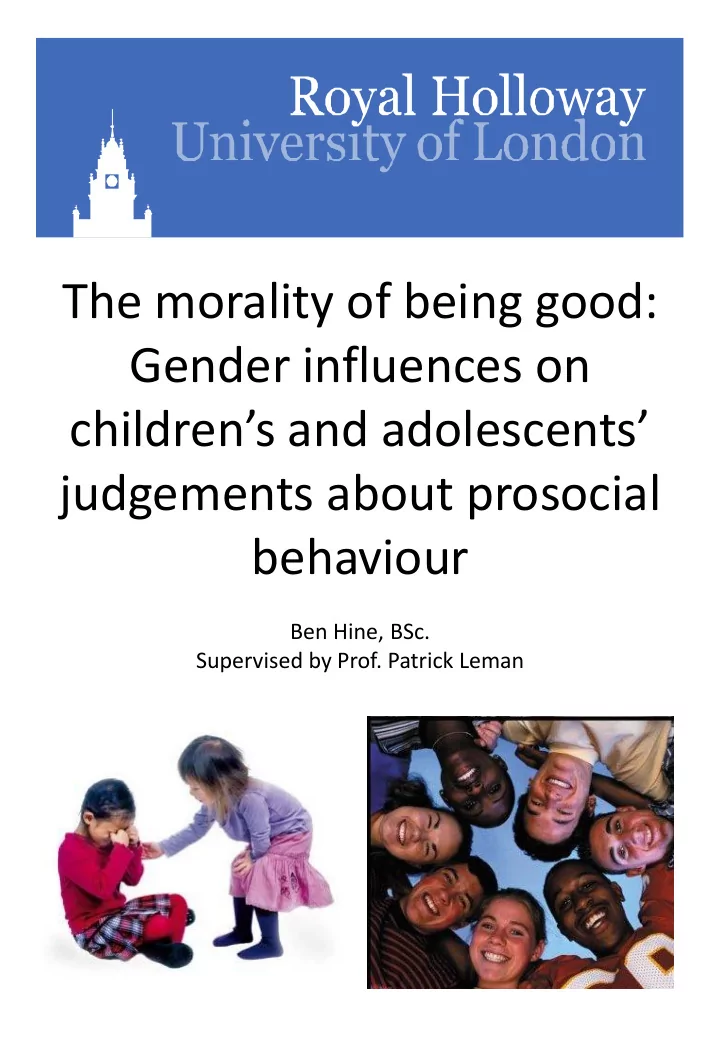

The morality of being good: Gender influences on children’s and adolescents’ judgements about prosocial behaviour Ben Hine, BSc. Supervised by Prof. Patrick Leman
The morality of being good: Gender influences on children’s and adolescents’ judgements about prosocial behaviour Ben Hine, BSc. Supervised by Prof. Patrick Leman Introduction The current study looked to investigate how judgements about children being prosocial or failing to be prosocial changed based on who was performing those actions (a boy or a girl). It also looked to investigate how judgements about which gender was more likely to perform certain actions changed over these years. It is predicted that prosocial behaviour will be judged as good, and failing to be prosocial as bad (as they are ‘right’ and ‘wrong actions respectively). However at age 13 years, judgements about boys being prosocial may change, as prosocial behaviour may be considered a girl action, an gender stereotypes are strongest at this age. Methods The overall sample consisted of 499 children (265 Boys, 234 Girls) from 3 schools in Staines and Martin’s Heron. These children were from year 2 (B = 70, G = 64), year 4 (B = 62, G = 63), year 6 (B = 62, G = 48), year 8 (B = 36, G = 34), and year 10 (B = 35, G = 25). This separated the children into five age groups: 6-7 years, 8-9 years, 10-11 years, 12-13 years, and 14-15 years. Children were presented stories where boys were being pro- and non-prosocial or girls were being pro- or non-prosocial, creating 4 conditions. The results are shown in the graph below. Mean Acceptability Judgements made about Individual Actions across 5 ages 6 5 Mean Judgements 4 Boys being Prosocial 3 Boys being Non-Prosocial Girls being Prosocial 2 Girls being Non-Prosocial 1 0 7 9 11 13 15 Age Group Y Axis: 1 = ‘Very Bad’ up to 5 = ‘Very Good’. Good/Bad judgements show relative acceptability of actions. Results and Conclusions 1 At age 13 (Year 8) judgements for boys being prosocial go down (this becomes less acceptable) and judgements for boys failing to prosocial go up (this becomes less unacceptable). So at this age, the expectancies about what boys can ‘get away with’ change, and this may be because prosocial behaviour is considered a feminine trait.
The morality of being good: Gender influences on children’s and adolescents’ judgements about prosocial behaviour Ben Hine, BSc. Supervised by Prof. Patrick Leman Mean judgements made about who is more likely to perform these two behaviours 0.5 0.4 0.3 Judgement Score 0.2 0.1 0 -0.1 -0.2 Prosocial Behavior -0.3 -0.4 Failing to be Prosocial -0.5 Boy Girl Gender of Participant Y Axis: - 1 = ‘Boys’, 0 = ‘Either Boys or Girls’, and 1 = ‘Girls’. In response to the question: “When you think of someone helping and sharing (or not helping and not sharing), who is more likely to do this?” Results and Conclusions 2 Boys Judgements: Boys do not judge prosocial behaviour or failing to be prosocial as significantly away from 0 (either). This shows that boys do not ‘gender’ these two actions, and believe that both boys and girls are equally as likely to perform these actions in everyday scenarios. Girls Judgements: Girls judge prosocial behaviour as significantly away from 0 (either) in a positive direction (towards girls). They also judge failing to be prosocial as significantly away from 0 (either) in a negative direction (towards boys). This shows that girls view prosocial behaviour as a feminine behaviour, and failing to be prosocial as a masculine one. Because boys and girls give different judgements, this would suggest that boys and girls view these behaviours in different ways. Whilst boys view these as gender neutral, girls think that prosocial behaviour is specifically performed by girls and not boys. This may contribute to a gender stereotype concerning prosocial behaviour as a female action, and this may be partly responsible for the differences in moral judgements seen regarding boys being prosocial seen above.
The morality of being good: Gender influences on children’s and adolescents’ judgements about prosocial behaviour Ben Hine, BSc. Supervised by Prof. Patrick Leman Take home messages: • At age 13 children view boys being prosocial as less acceptable • Girls judge prosocial behaviour as a female behaviour and non- prosocial behaviour as a male behaviour • Girls are most gendered in their judgements • Boys, especially at age 13 need to be pushed towards prosocial behaviour • Children need to be educated at all levels of schooling with regards to attitudes concerning the importance of being prosocial regardless of gender The work described in this pack is only possible with the support of institutions such as yourself and the staff therein. The support that your school has provided, and continues to provide, is greatly appreciated. Hopefully these findings will add knowledge to the field concerning gender stereotypes, and aid the production of successful policy reviews that may help change negative behaviours. Thank you very much. For more information (if required) please feel free to contact me: Ben Hine, BSc. B.Hine@rhul.ac.uk 01784 276627 07870 109326 Or my supervisor: Prof. Patrick Leman Patrick.Leman@rhul.ac.uk 01784 414406
Recommend
More recommend